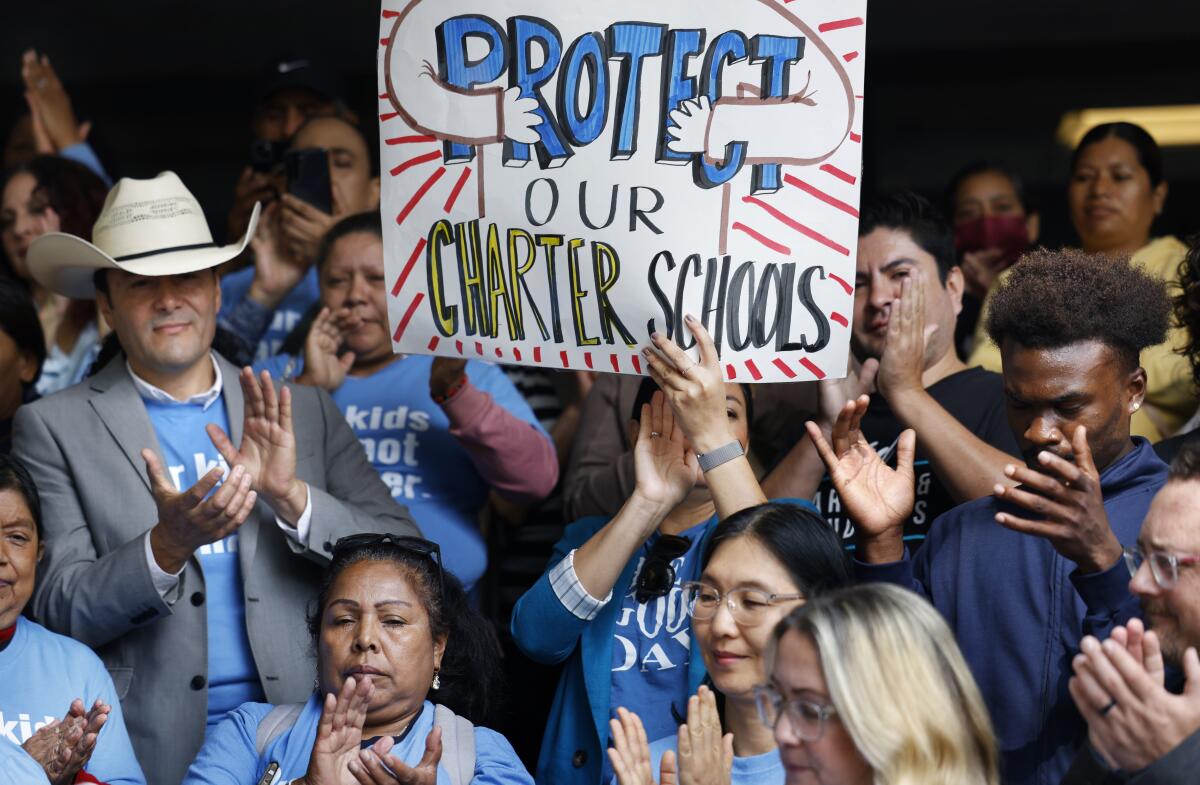L.A. Unified’s new restrictions on charter schools go too far

- Share via
Note to the Los Angeles Unified school board: Kids in local charter schools are your kids, too. They are, for the most part, students who would have been attending traditional L.A. public schools but whose parents chose to enroll them in one of the nearly 250 publicly funded but mostly privately managed schools.
In an era of falling enrollment, the district is in a tough position when it loses students to charter schools. Each student brings in considerable state funding, which pays for instruction and a vast array of social and administrative services. So the district’s concerns that fewer students will lead to budget cuts are understandable.
But those concerns must come second to what’s best for the public school students of L.A., whether they attend a charter or traditional district school.
While the presidential contest will garner the most attention in 2024, there are many important races and measures on state and local ballots.
On Tuesday, the school board narrowly voted to adopt a new policy restricting where charter schools can share campuses with traditional schools. The change goes too far toward protecting the district’s interests while putting too low a priority on what works best for all students. The policy is too vague to know exactly what the ramifications are, but one estimate by an L.A. Unified staffer said some 350 of the district’s 850 schools would be off-limits to charter schools. Surely that’s unnecessary when only 50 campuses are shared with charter schools right now; most of the district’s charter schools have their own, independent campuses.
The new policy may well violate the state Education Code that says that public school facilities should be shared fairly among public school students and that charter schools are entitled to rent parts of district schools.
The strike talk was mostly about new hiring, smaller class sizes and salary increases.
Of course, traditional schools should not have to squeeze themselves into a corner of campus to accommodate a charter school. But this policy isn’t about protecting necessary space; it’s about squashing charter schools. Sharing of campuses would be discouraged at schools with special programs for Black students and those with low achievement levels. Only in the case of community schools, which do require more facilities because they provide an array of services to students and the neighborhood, does the rule seem to have any connection to the actual space needs of a school. But there are charter schools that also are community schools; will the district give them preference?
And, if any further indication is needed that the intent is to shrink the influence of charter schools, the policy discourages allowing a charter on a campus if it could interrupt traditional feeder-school patterns. For example, if an elementary school shares its campus with a charter middle school, parents might be inclined to enroll their kids in the charter middle school to keep them on the same campus rather than having them attend the local district-run middle school.
Will the LAUSD find a way to support, even magnify, that rarest of success stories: A high-achieving predominantly Black neighborhood school?
Parents choose schools based on their perception of where their children will receive the best education, and for too long they had no choice but to accept whatever school the district gave them, which was often subpar. They’ll enroll their kids in the traditional middle school and high school if those offer a superior education, exciting programs and an inviting environment. That’s the appropriate way for the district to keep its feeder-school system humming.
It’s especially disturbing to hear board members Rocio Rivas and Scott Schmerelson implying that this is just the start of more policies to curb charter schools. Schmerelson won The Times’ endorsement for a final term on the school board in part because he presented himself as a centrist who had supported various charter schools in the past. It is especially troubling to hear him say that he intends to continue this campaign against shared campuses.
Charter schools aren’t the ultimate answer to low achievement, and they’re suffering their own enrollment setbacks. Highly regarded charter operator Kipp SoCal Public Schools is closing three of its 23 schools in the area because they are underenrolled. But many charter schools have given a significant boost to students, especially those most in need of help, and they give families more educational choices.
There are shared campuses in L.A. Unified where traditional and charter schools get along well, exchange resources and learn from each other. Why doesn’t the school district find out what makes them work and seek to emulate this at other campuses instead of setting schools against each other? Public school students should not be caught in the middle of this turf war.
More to Read
A cure for the common opinion
Get thought-provoking perspectives with our weekly newsletter.
You may occasionally receive promotional content from the Los Angeles Times.












